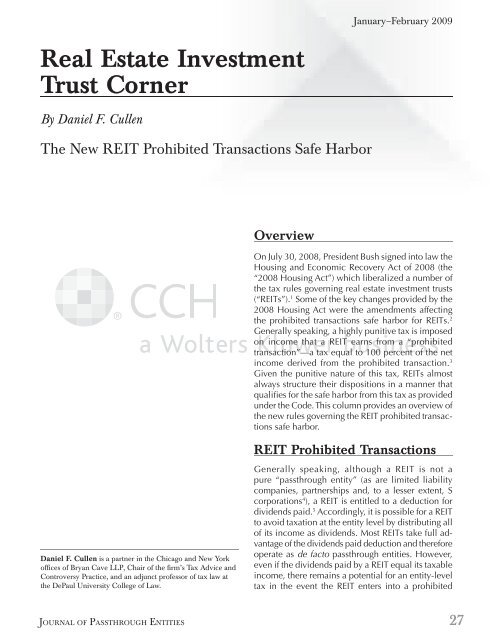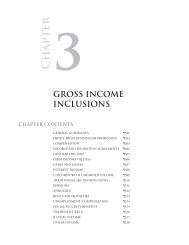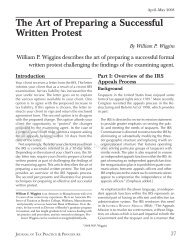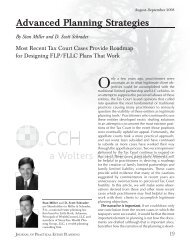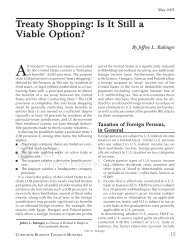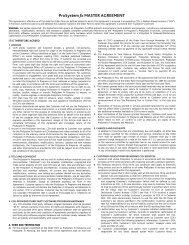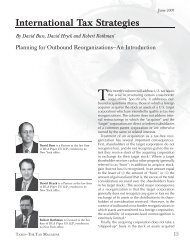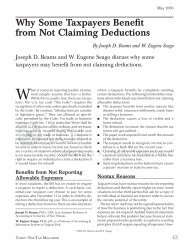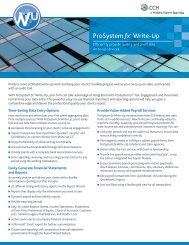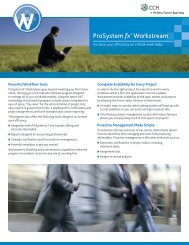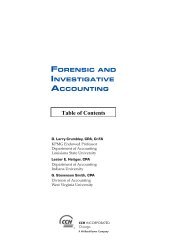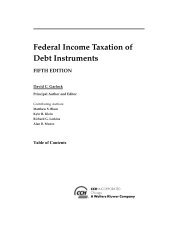REIT Prohibited Transactions - CCH
REIT Prohibited Transactions - CCH
REIT Prohibited Transactions - CCH
Create successful ePaper yourself
Turn your PDF publications into a flip-book with our unique Google optimized e-Paper software.
January–February 2009<br />
Real Estate Investment<br />
Trust Corner<br />
By Daniel F. Cullen<br />
The New <strong>REIT</strong> <strong>Prohibited</strong> <strong>Transactions</strong> Safe Harbor<br />
Overview<br />
On July 30, 2008, President Bush signed into law the<br />
Housing and Economic Recovery Act of 2008 (the<br />
“2008 Housing Act”) which liberalized a number of<br />
the tax rules governing real estate investment trusts<br />
(“<strong>REIT</strong>s”). 1 Some of the key changes provided by the<br />
2008 Housing Act were the amendments affecting<br />
the prohibited transactions safe harbor for <strong>REIT</strong>s. 2<br />
Generally speaking, a highly punitive tax is imposed<br />
on income that a <strong>REIT</strong> earns from a “prohibited<br />
transaction”—a tax equal to 100 percent of the net<br />
income derived from the prohibited transaction. 3<br />
Given the punitive nature of this tax, <strong>REIT</strong>s almost<br />
always structure their dispositions in a manner that<br />
qualifies for the safe harbor from this tax as provided<br />
under the Code. This column provides an overview of<br />
the new rules governing the <strong>REIT</strong> prohibited transactions<br />
safe harbor.<br />
<strong>REIT</strong> <strong>Prohibited</strong> <strong>Transactions</strong><br />
Daniel F. Cullen is a partner in the Chicago and New York<br />
offices of Bryan Cave LLP, Chair of the firm’s Tax Advice and<br />
Controversy Practice, and an adjunct professor of tax law at<br />
the DePaul University College of Law.<br />
Generally speaking, although a <strong>REIT</strong> is not a<br />
pure “passthrough entity” (as are limited liability<br />
companies, partnerships and, to a lesser extent, S<br />
corporations 4 ), a <strong>REIT</strong> is entitled to a deduction for<br />
dividends paid. 5 Accordingly, it is possible for a <strong>REIT</strong><br />
to avoid taxation at the entity level by distributing all<br />
of its income as dividends. Most <strong>REIT</strong>s take full advantage<br />
of the dividends paid deduction and therefore<br />
operate as de facto passthrough entities. However,<br />
even if the dividends paid by a <strong>REIT</strong> equal its taxable<br />
income, there remains a potential for an entity-level<br />
tax in the event the <strong>REIT</strong> enters into a prohibited<br />
JOURNAL OF PASSTHROUGH ENTITIES 27
Real Estate Investment Trust Corner<br />
transaction, subjecting the <strong>REIT</strong> to a 100-percent tax<br />
on the net income earned from such transaction. 6<br />
A prohibited transaction is generally defined as the<br />
sale or other disposition of property that is described<br />
in Code Sec. 1221(a)(1) and which is not foreclosure<br />
property. One type of property described under Code<br />
Sec. 1221(a)(1) is real estate held by a the taxpayer<br />
primarily for sale to customers in the ordinary course<br />
of business (“dealer property”). Unfortunately, classifying<br />
an investment as “dealer property” is one of<br />
the most litigated and difficult areas of tax law.<br />
The determination of<br />
whether a specific property<br />
or real estate project<br />
is described in Code Sec.<br />
1221(a)(1) is an issue that<br />
turns on the facts and circumstances<br />
of each case.<br />
In Malat v. Riddel, 7 the<br />
Supreme Court (in one<br />
of its only discussions of<br />
the definition of “dealer<br />
property”) held that where<br />
both a business motive<br />
and investment motive for holding a particular parcel<br />
of real estate exists, the taxpayer’s primary motivation<br />
controls in determining whether the property was<br />
held primarily for sale to customers (i.e., as dealer<br />
property). Because the inquiry into a taxpayer’s motivation<br />
for owning a particular piece of real property<br />
is a factual one, the courts have developed sets of<br />
factors to help determine whether the asset was held<br />
for investment or as dealer property. The following list<br />
set forth in United States v. Winthrop 8 is representative<br />
of factors most often considered by the courts<br />
(many of which are interrelated questions and even<br />
somewhat duplicative):<br />
1. the nature and purpose of the acquisition of the<br />
property and the duration of the ownership;<br />
2. the extent and nature of the taxpayer’s efforts<br />
to sell the property;<br />
3. the number, extent, continuity and substantiality<br />
of the sales;<br />
4. the extent of subdividing, developing and improving<br />
the property that was done to increase<br />
sales;<br />
5. the use of a business office and advertising for<br />
the sale of the property;<br />
6. the character and degree of supervision or<br />
control exercised by the taxpayer over any<br />
representative selling the property; and<br />
Due to the devastatingly punitive<br />
tax imposed on a <strong>REIT</strong> that<br />
engages in a prohibited transaction,<br />
the safe harbor for avoiding<br />
prohibited transaction status is<br />
critical to <strong>REIT</strong>s when entering<br />
into proposed transactions.<br />
7. the time and effort the taxpayer actually devotes<br />
to the sale of the property.<br />
Although a list of factors to consider is helpful, the<br />
Fifth Circuit simplified the complexity of the application<br />
of these factors in Biedenharn Realty Co. v.<br />
U.S. 9 as follows:<br />
No one set of criteria is applicable to all economic<br />
structures. Moreover, within a collection of tests,<br />
individual factors have varying weights and magnitudes,<br />
depending on the facts of the case. The<br />
relationship among the<br />
factors and their mutual<br />
<strong>Prohibited</strong> Transaction<br />
Safe Harbor<br />
interaction is altered as<br />
each criteria increases or<br />
diminishes in strength,<br />
sometimes changing the<br />
controversy’s outcome.<br />
Fortunately, the Code<br />
provides a “safe harbor,”<br />
which allows most <strong>REIT</strong>s to<br />
avoid the “investment” vs.<br />
“dealer property” issue.<br />
The <strong>REIT</strong> prohibited transaction safe harbor provided<br />
in Code Secs. 857(b)(6)(C) and (D) helps mitigate<br />
the uncertainty of determining whether sales are<br />
prohibited transactions. The safe harbor excludes<br />
certain sales of real estate (or timber assets) from the<br />
definition of prohibited transactions largely based<br />
upon the scale of the <strong>REIT</strong>’s sales activities.<br />
To qualify for the safe harbor during a given tax<br />
year, either (1) the <strong>REIT</strong> must have made no more<br />
than seven sales of property (other than sales of<br />
foreclosure property or sales that are involuntary<br />
conversions) (the “7-Sales Test”), or (2) if more than<br />
seven sales were made, the aggregate adjusted<br />
bases of the properties sold (other than foreclosures<br />
or sales that are involuntary conversions) must not<br />
exceed 10 percent of the aggregate bases of all the<br />
<strong>REIT</strong>’s assets as of the beginning of the tax year<br />
(the “10-Percent-Bases Test”). Code Sec. 857(b)(6)<br />
(E) further provides that the sale of more than one<br />
property to one buyer as part of the same transaction<br />
constitutes one sale for purposes of the 7-Sales<br />
Test, and any sale in which the net selling price is<br />
less than $10,000 is excluded. Practically speaking,<br />
28<br />
©2009 <strong>CCH</strong>. All Rights Reserved.
January–February 2009<br />
the 10-Percent-Bases Test recognizes the simple fact<br />
that large <strong>REIT</strong>s must acquire and sell numerous<br />
properties each year and frequently must enter into<br />
more than seven sales of their investment real estate<br />
in any given year, often making the 7-Sales Test of<br />
no use to them. Accordingly, most large <strong>REIT</strong>s have<br />
relied on the 10-Percent-Bases Test.<br />
In addition to the above requirements, it is critical<br />
to note that to qualify for this safe harbor, the following<br />
additional requirements must be met: (1) the<br />
<strong>REIT</strong> property at issue must be held for a minimum<br />
of four years, and (2) the <strong>REIT</strong> cannot have made<br />
improvements to such property during that period<br />
that represent more than 30 percent of the net sales<br />
price of a property. 10<br />
The legislative history indicates that Congress created<br />
this highly punitive tax to discourage <strong>REIT</strong>s from<br />
engaging in “ordinary retailing activities such as sales<br />
to customers of condominium units or subdivided<br />
lots in a development project.” 11 Congress believed<br />
that “<strong>REIT</strong>s should have a safe harbor within which<br />
they can modify the portfolio of their assets without<br />
the possibility that a tax would be imposed equal<br />
to the entire appreciation in those assets” and that<br />
the restrictions on the availability of <strong>REIT</strong>s to avail<br />
themselves of the safe harbor would “prevent <strong>REIT</strong>s<br />
from using the safe harbor to engage in an active<br />
trade of business such as the development and subdivision<br />
of land.” 12<br />
Changes Made by the 2008<br />
Housing Act<br />
As discussed above, prior to the enactment of the<br />
2008 Housing Act, Code Secs. 857(b)(6)(C)(iii) and<br />
(D)(iv) provided that the prohibited transaction safe<br />
harbor applied only if:<br />
1. the <strong>REIT</strong> held the property for the production of<br />
rental income for at least four years prior to sale;<br />
2. the aggregate capital expenditures made by the <strong>REIT</strong><br />
for a property during the four-year holding period<br />
preceding the sale had not exceeded 30 percent of<br />
the net selling price of the property; and<br />
3. during the tax year:<br />
(a) the <strong>REIT</strong> made no more than 7 sales of property<br />
(other than foreclosures or sales to which<br />
Code Sec. 1033 (involuntary conversions)<br />
applied); or<br />
(b) the aggregate adjusted bases (as determined<br />
for purposes of computing earnings and<br />
profits) of properties (other than foreclosures<br />
or involuntary conversions) sold during the<br />
tax year did not exceed 10 percent of the aggregate<br />
bases of all of the assets of the <strong>REIT</strong><br />
as of the beginning of the taxable year.<br />
Section 3052 of the 2008 Housing Act amended<br />
Code Secs. 857(b)(6)(C)(iii) and (D)(iv) to provide an<br />
additional alternative test for the number of permitted<br />
property sales by a <strong>REIT</strong>. Under this alternative test,<br />
the requirements of Code Secs. 857(b)(6)(C)(iii) or<br />
(D)(iv) are satisfied if the aggregate fair market value<br />
of properties (other than foreclosures or involuntary<br />
conversions) sold during the tax year does not exceed<br />
10 percent of the fair market value of all of the assets<br />
of the <strong>REIT</strong> as of the beginning of the taxable year<br />
(the “10-Percent Fair Market Value Test”). Substituting<br />
“aggregate fair market value” test for “aggregate<br />
adjusted bases” test in the permitted sales equation<br />
portion of the <strong>REIT</strong> prohibited transactions safe harbor<br />
should provide <strong>REIT</strong>s with much needed flexibility in<br />
managing their real estate portfolios for their investors<br />
in the midst of the current economic environment.<br />
In addition, the 2008 Housing Act changed the<br />
holding period requirements of the <strong>REIT</strong> prohibited<br />
transactions safe harbor: both (1) the holding period<br />
during which the <strong>REIT</strong> is required to hold the property<br />
and (2) the period during which the 30-percent<br />
limit on capital expenditures is measured is reduced<br />
from four years to two years. This change also provides<br />
much needed flexibility to <strong>REIT</strong> in managing<br />
their portfolios.<br />
Revenue<br />
Procedure 2008-69<br />
The amendments provided under the 2008 Housing<br />
Act were made effective for sales made after July<br />
30, 2008. However, because the effective date was<br />
expressed in terms of sales made after a particular<br />
date, questions arose about how to interpret the new<br />
10-Percent Fair Market Value Test for substantive provisions<br />
that apply as alternatives and are expressed<br />
in terms of sales during a tax year. To address this<br />
concern, the IRS issued Rev. Proc. 2008-69, 13 which<br />
provides the following clarification for applying the<br />
10-Percent Fair Market Value Test:<br />
[f]or a <strong>REIT</strong>’s taxable year that begins on or<br />
before July 30, 2008, and ends on or after July<br />
31, 2008, satisfaction of [Code Secs.] 857(b)(6)<br />
(C)(iii) or of [Code Secs.] 857(b)(6)(D)(iv) means<br />
that either —<br />
JOURNAL OF PASSTHROUGH ENTITIES 29
Real Estate Investment Trust Corner<br />
The <strong>REIT</strong> satisfies the 7-Sales Test (for the entire<br />
taxable year);<br />
The <strong>REIT</strong> satisfies the 10-Percent Adjusted Bases<br />
Test (for the entire taxable year); or<br />
Both—[t]he aggregate adjusted bases (as determined<br />
for purposes of computing earnings and<br />
profits) of property (other than sales of foreclosure<br />
property or sales to which [Code Sec.] 1033 (involuntary<br />
conversions) applies) sold during the<br />
portion of the taxable year ending on July 30,<br />
2008, did not exceed 10 percent of the aggregate<br />
bases (as so determined) of all of the assets of<br />
the <strong>REIT</strong> as of the beginning of the taxable year<br />
(that is, the <strong>REIT</strong> satisfies the 10-Percent Adjusted<br />
Bases Test as if the portion of the taxable year<br />
ending on July 30, 2008, were an entire taxable<br />
year); and [t]he <strong>REIT</strong> satisfies the 10-Percent Fair<br />
Market Value Test (for the entire taxable year)<br />
(emphasis added).<br />
Conclusion<br />
Due to the devastatingly punitive tax imposed on<br />
a <strong>REIT</strong> that engages in a prohibited transaction, the<br />
safe harbor for avoiding prohibited transaction status<br />
is critical to <strong>REIT</strong>s when entering into proposed<br />
transactions. Because the determination of whether<br />
a taxpayer is acting as a dealer is often murky at best<br />
(and, at times, dark as mud), most <strong>REIT</strong>s rely strictly<br />
on the safe harbor, rather than wade into the murky<br />
waters of “dealer property” determinations. The<br />
alternative tests provided by the 2008 Housing Act<br />
grants much needed additional flexibility to <strong>REIT</strong>s<br />
to dispose of assets during these troubled economic<br />
times without having to take on the often difficult<br />
“dealer property” analysis and assume the related<br />
tax audit risk for such determinations.<br />
1<br />
Housing and Economic Recovery Act of 2008<br />
(P.L. 110-289). Many of the provisions in the<br />
2008 Housing Act impacting <strong>REIT</strong>s were<br />
proposed by NA<strong>REIT</strong> in 2007. A discussion of<br />
all of the <strong>REIT</strong> provisions in the 2008 Housing<br />
Act is outside the scope of this column.<br />
2<br />
See Code Secs. 857(b)(6)(C) and (D).<br />
3<br />
Code. Sec. 857(b)(6).<br />
4<br />
Note, however, the following provisions applicable<br />
to S corporations: Code Secs. 1374<br />
(tax imposed on certain built-in gains) and<br />
ENDNOTES<br />
1375 (tax generally imposed when passive<br />
investment income of corporation having<br />
subchapter C earnings and profits exceeds<br />
25 percent of gross receipts).<br />
5<br />
Code Secs. 857 and 561.<br />
6<br />
Code Sec. 857(b)(6).<br />
7<br />
Malat v. Riddell, SCt, 66-1 USTC 9317, 383<br />
US 569, 86 SCt 1030.<br />
8<br />
A.B. Winthrop, CA-5, 69-2 USTC 9686, 417<br />
F2d 905.<br />
9<br />
Biedenharn Realty Co., Inc., CA-5, 76-1 USTC<br />
9194, 526 F2d 409.<br />
10<br />
See Code Secs. 857(b)(6)(C), (C)(ii), (D)(i)<br />
and (D)(ii).<br />
11<br />
S. Rept. No. 94-938, 94th Cong., 2d Sess.<br />
470 (1976).<br />
12<br />
S. Rept. No. 95-1263, 95th Cong., 2d Sess.<br />
178-179 (1978).<br />
13<br />
Rev. Proc. 2008-69, IRB 2008-48 (Nov. 13,<br />
2008).<br />
This article is reprinted with the publisher’s permission from the JOURNAL OF PASSTHROUGH ENTITIES,<br />
a bi-monthly journal published by <strong>CCH</strong>, a Wolters Kluwer business. Copying or distribution<br />
without the pub lish er’s permission is pro hib it ed. To subscribe to the JOURNAL OF PASSTHROUGH<br />
ENTITIES or other <strong>CCH</strong> Journals please call 800-449-8114 or visit www.<strong>CCH</strong>Group.com.<br />
All views ex pressed in the articles and col umns are those of the author and<br />
not necessarily those of <strong>CCH</strong> or any other person. All Rights Reserved.<br />
30<br />
©2009 <strong>CCH</strong>. All Rights Reserved.


